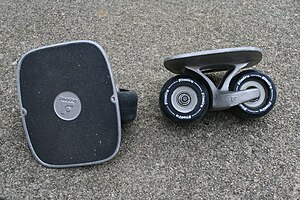Freeline skate
The term Freeline Skate stands for a fun sport device that is a mixture of a - halved - skateboard and shoeless inline skates and with which to a certain extent the driving behavior of a snowboard on asphalt can be imitated. A pair of skates is required to ride. The sequence of movements when driving is similar to that of snakeboarding .
construction
The skate consists of a 17 × 14 cm plate made of cast aluminum , under which two inline rollers are fixed behind one another. Roll holder and plate are a single casting. The 70mm rollers use ABEC 5 bearings. The top of the plate has no shoes or bindings, but is covered with griptape to increase the grip. The driver's foot is centered on the plate, parallel to its long side (see sketch).
The two skates of a pair differ from each other in that the rollers are not at right angles to the position of the feet, but rather slightly forward on the outside of the respective foot (see sketch). So there is a clearly left and right skate.
Drive
The locomotion takes place characteristically in snake movements, since the propulsion is not generated by pushing, but by rotating movements of the upper body in connection with counter-movements of the feet. The upper body stands sideways to the direction of travel. With this sequence of movements, called S-shape, the speed of an average cyclist can be achieved, even inclines can be mastered in this way. A higher speed can also be achieved when driving downhill on slopes.
Board-specific tricks and jumps are possible, as well as driving on halfpipes and ramps.
Braking is done by tight curves or jumping off. Protective measures (helmet, knee, elbow and hand protection) are recommended.
development
The Freeline Skate was developed by Ryan Farrelly and introduced to the California skater scene with the help of Jason Galoob . Since 2005 Freeline Skates have been manufactured by the company "Freeline Skates, Inc.". After their bankruptcy in 2015, skater Mattie Tyce helped found "JMKRide", which now sells similar models. Professional skaters in Japan refer to the sport as "free skates" and in Taiwan "drift skates" is preferred to avoid the identity of the sport with the bankrupt manufacturer "Freeline Skates, Inc." to link.
While freeline skates have already become a trend sport in the United States of America , freeline skates have only recently become available in Germany. At the German Sport University Cologne there is a working group (Freeliner-AG) that aims to increase awareness of freeline sports.
swell
- Thilo Folz: Like from Mars . In: Kölner Stadt-Anzeiger (Cologne, No. 140, June 18, 2008)
Remarks
- ↑ “[...] the feet generate the lateral propulsion by turning them acyclically towards and away from each other. The force impulse is additionally supported by shifting the upper body back and forth, depending on the movement element. "(Thilo Folz: Wie vom Mars . Kölner Stadt-Anzeiger)
Web links
- JMKRIDE - Successor brand founded by former employees after Freeline went bankrupt and disappeared: jmkride.com
- German-Freeline-Scene - The German community for the trend sport Freeline-Skating: www.german-freeline-scene.eu
- Swiss-Freeline-Scene - The Swiss community for the trend sport Freeline-Skating: www.swiss-freeline-scene.ch
- twenty4action - Official European representation of JMKRIDE: twenty4action.com

